Toshiba X305-Q725: Quad-Core Gaming Notebook
by Jarred Walton on March 11, 2009 1:00 AM EST- Posted in
- Laptops
Gaming Performance
We've chosen to focus on "reasonable" settings for the games below. That means we run Assassin's Creed and Company of Heroes in DX9 mode at maximum detail setting - DX10 reduces performance by quite a bit in AC and by a much larger amount in CoH. We run Crysis at Medium settings (for reference, High detail drops performance almost in half: 18.3FPS). The remaining games are at maximum detail settings, but without any anti-aliasing. Some titles can certainly handle higher detail settings - Fallout 3 for instance will work fine at up to 1920x1200 0xAA and maximum detail, and the same holds for other games - however, we chose to focus on 1680x1050 performance because of the X305 LCD and because that resolution offers more consistently playable performance on gaming laptops.
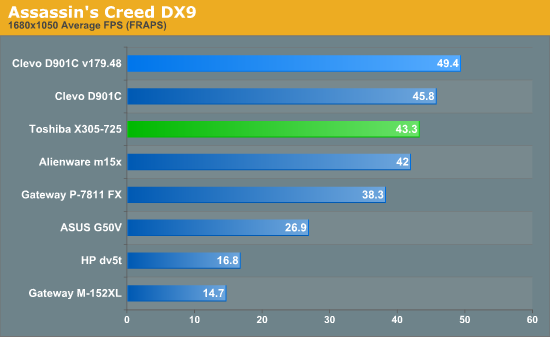
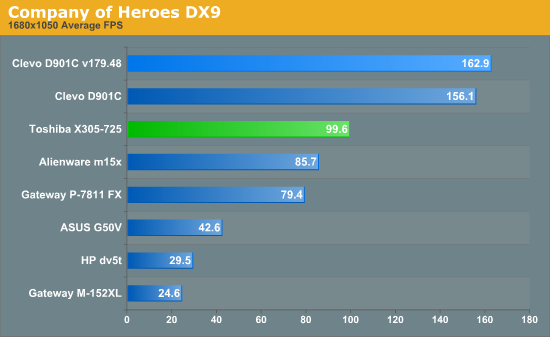
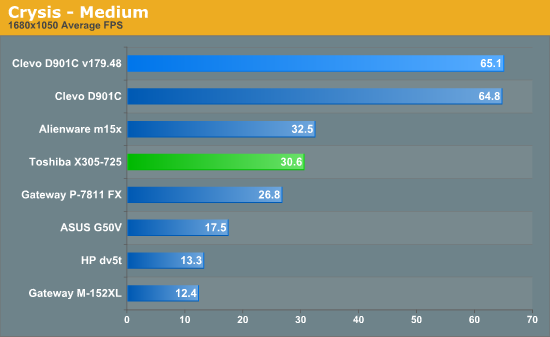
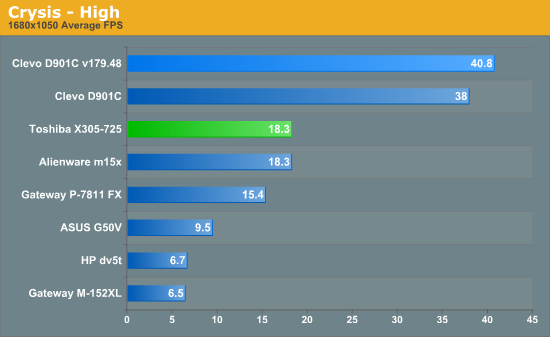
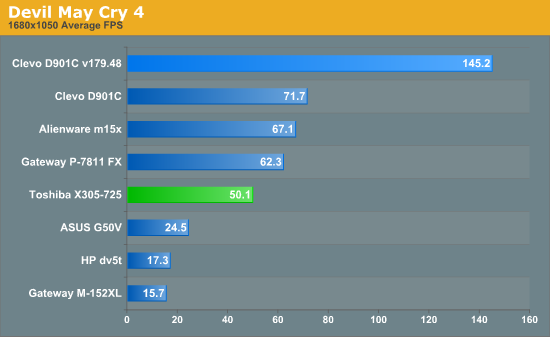
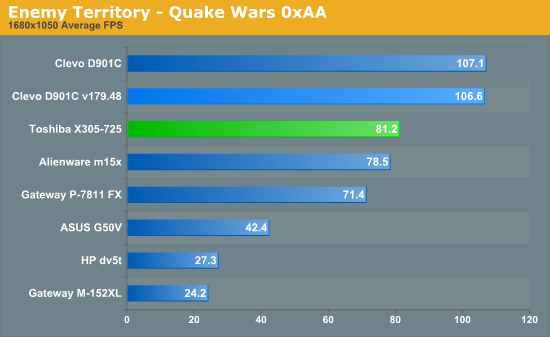

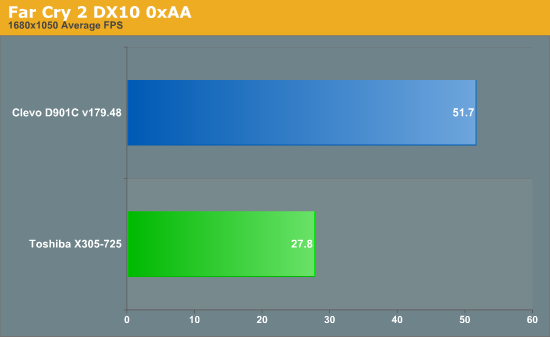
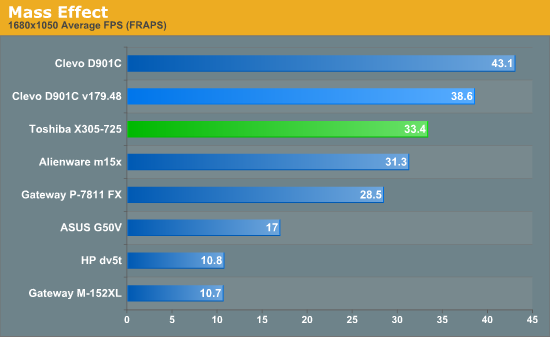
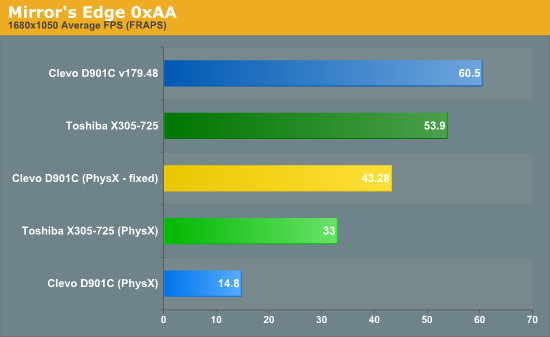
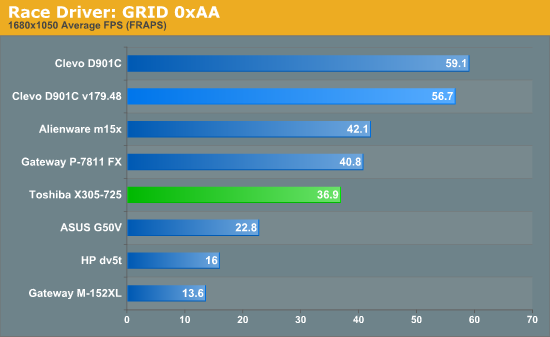
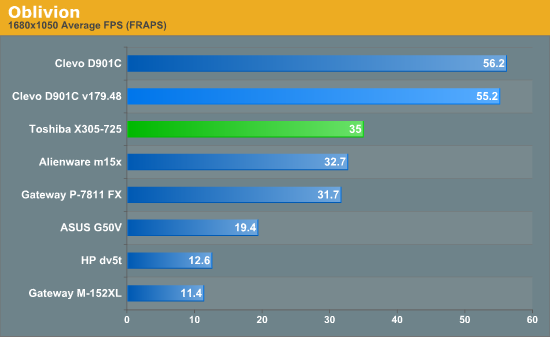
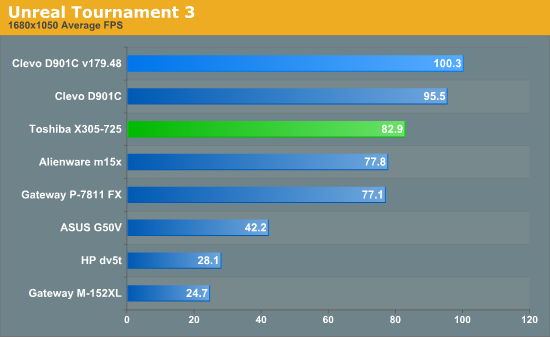
We do run into several situations where the detail settings create system bottlenecks, but overall the SLI 8800M GTX configuration in the Clevo laptop is clearly superior to a single 9800M GTX.
Assassin's Creed likes CPU performance almost as much as GPU power, so the lower clock speed of the Q9000 definitely has an impact here. DX10 performance is acceptable as well and helps to reduce the CPU clock speed penalty, but the overall look of the game isn't substantially changed and performance is still better in all cases under DX9. Enemy Territory: Quake Wars, Fallout 3, Mass Effect, Mirror's Edge, and Unreal Tournament 3 are all in a similar situation. The GPU advantage of the D901C does allow 1920x1200 game play in all of these titles and should increase the margin of victory, but most of these titles are hitting other bottlenecks.
Company of Heroes, Crysis, Devil May Cry 4, Far Cry 2, Oblivion, and GRID all show a greater than 50% performance advantage to the Clevo D901C notebook relative to the X305-Q725. Again, keep in mind that these two notebooks are priced quite similarly, so if you're after raw performance and don't mind a slightly heavier (and perhaps less attractive) chassis the D901C is the clear winner. The dual-core 3.0GHz CPU is a much better choice right now in gaming, though you could install up to a Q9550 if you prefer quad-core processors for non-gaming purposes.
Of all the games we tested, only one title shows any advantage to the 9800M GTX over the 8800M GTX SLI: Mirror's Edge. The advantage is further limited to situations where PhysX support is enabled; otherwise the 8800M SLI is slightly faster. We have not yet confirmed with NVIDIA whether this is a driver bug or is caused by a lack of appropriate hardware on the 8800M GPUs, but we would assume it's a driver issue. The PhysX effects do look nice at times, but even the X305 hits plenty of situations where performance can drop dramatically, and we'd recommend leaving PhysX disabled on these laptop GPUs.
Update: We discussed the Mirror's Edge PhysX issue with NVIDIA and they recommended a manual install of the PhysX drivers just to ensure they were working properly. It looks like the unified graphics/PhysX driver failed to work properly, although the system seemed to think the drivers installed properly. We uninstalled PhysX, rebooted, and installed the drivers again, and that cleared up the performance issue. As you can see, the performance of the D901C is now where you would expect, coming in 33% faster than the X305-Q725.
In the past, we've been hesitant to strongly recommend any laptops with dual GPUs, simply because the drivers were not updated frequently enough to make that a viable solution for long-term gaming pleasure. NVIDIA has now addressed the major stumbling block for SLI in a laptop, so for the mobile gamers we would definitely recommend an SLI notebook over the X305-Q725. In a best case scenario, dual GTX 280M GPUs (with the appropriate CPU) should end up providing around 50% more performance than the 8800M GTX SLI represented by the Clevo D901C, and potentially more than twice the performance of the single 9800M GTX in the X305-Q725.
Before you get too excited about the potential for mobile gaming, we do need to give a few words of caution about relative performance. The GTX 280M may be the fastest current gaming solution for notebooks, but at its core the GTX 280M is nothing more than a mobile version of the GeForce 9800 GTX. The desktop GTX 280/285 (and Radeon HD 4870) are well out of reach of anything a laptop can achieve and should remains so for some time. Short of external cards that connect via ExpressCard adapters, gamers looking for maximum performance will want to play on a desktop, and ExpressCard adapters are hardly a panacea - is anyone really going to get a laptop only to add a secondary device that requires a separate power source? I can't say the prospect is very appealing to me at any rate.










32 Comments
View All Comments
Dfere - Thursday, March 12, 2009 - link
A business power user needs some mobility. I use a laptop as my main business computer. It would be nice to have something to play games at an ok rate. But given the bugs, let alone the power issues, I wouldn't. I need some mobility and I need my data and system operational to make revenue.A plain gamer/laptop lover wouldn't because it isn't a top performer, and thats why they buy.
JimmiG - Thursday, March 12, 2009 - link
I used to travel a lot between point A and point B and wanted a good gaming system at both places. I was considering a gaming laptop for a while but ended up building myself a Shuttle SFF system instead. Fit perfectly in the backpack together with my other belongings, cost about 1/4th of a gaming laptop and offered 95% of the performance of a full tower system. I just used a cheap 19" CRT monitor at one place and the LCD at the other. Amazing how small and light that system was.Of course if you travel a lot between many different location, this kind of laptop might make sense. Just hook it up when you arrive at the hotel room, cabin etc., and you've got a full gaming setup. Of course, if you don't care about games, you'd be better served by a netbook or 13" laptop...
Enoc - Wednesday, March 11, 2009 - link
with the AMD/Ati 4850 and 4870 for mobile... why these companies still use the renamed 9400/9500/9600/9800gt/gtx...? and what it worse some people think the GTX 280M is the same as the deskstop counterpart but is really a 9800GTX...
AMD has a good oportunity if more OEM embrace the 4850/4870 for the enthusiast notebook segment like MSI has done and if they introduce low power(HE) quads and triple cores for this segment that would be a nice move...
with $1500+- you could build something better with a compal/saeger barebone...
JarredWalton - Thursday, March 12, 2009 - link
Sager doesn't make barebones, I don't think; they use Clevo offerings. But yes, you can put together a better custom system I think. Pricing might not be much better, though.Memph - Wednesday, March 11, 2009 - link
I'v had similar expiriences with my qosmio. The problems in the old drivers. have to uninstall them (twice) from the safe mode. and then install the newest nvidia drivers. Mine used to lock up randomly. Now everything works perfectly.jabber - Wednesday, March 11, 2009 - link
I've had several laptops over the years. Best fix I've found for stability is to blitz the manufacturers build asap and slap on a fresh build with the latest OS. Go to the manufacturers site for drivers that you cant find elsewhere as they will generally be two or three versions on from the ones the laptop came with.There will also be a new BIOS update usually.
Has always got rid of the quirks for me.
JarredWalton - Wednesday, March 11, 2009 - link
FWIW, the instability issue always cropped up with a graphics application - game - running. (Well, there was the SysInfo issue with 3D/PCMark Vantage, but that's clearly a driver problem that they addressed.) I did run Folding@Home SMP on the laptop non-stop for several days with no crashes caused there. I did not test the GPU folding client, though, which would have been interesting to check now that I think about it.Personally, I do not run Folding@Home on laptops (anymore); it just places a huge load on the system and is almost asking your laptop to die a premature death. For that matter, I've stopped running it on most of my desktops as well - power costs for all the running computers were too much, so it's much cheaper to just leave them off when they're not in use.
Wolfpup - Wednesday, March 11, 2009 - link
Be funny to people? My notebook is my main system...I mean why not?Anyway, I'm so glad Anandtech is continuing to cover power laptops!
I hate how gaudy this is, but I'd certainly consider it if not for the lack of Blu Ray and LED backlight. I actually prefer the single high end GPU route...
Plus obviously the instability is disturbing. Must be a hardware defect somewhere, or else a bad driver. I've been Folding non stop on the CPU and GPU of my (much lower end) Asus n80 with a Penryn/Geforce 9650GT and it hasn't crashed once.
piroroadkill - Wednesday, March 11, 2009 - link
17" is too large for a notebook in my opinion, even a gaming one. 15.4" widescreen @ 1680x1050 would be perfect. Also how did they manage to make this thing so goddamn thick?!Blahman - Friday, March 13, 2009 - link
Check this one out, matches your requirements exactly: http://www.msimobile.com/level3_productpage.aspx?c...">http://www.msimobile.com/level3_productpage.aspx?c...